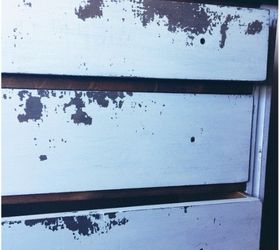So let's talk about the pros and cons of each kind of paint:
Milk Paint:
* Casein, a milk protein, is one of the ingredients in milk paint, which is how it got its name.
* It's made from completely natural ingredients and has been around as a paint medium forever (seriously, like forever).
* You don't have to sand or use a primer with milk paint...but be aware, it has a mind of its own! If it decides to chip on a piece, it's just gonna go right ahead and do it...no rhyme or reason (I love this about milk paint, but some people find it extremely frustrating to work with an unpredictable medium).
* Good news for those of you that need to feel complete control over your project... MMS line has a Bonding Agent you can use if you don't want the chippy goodness. This is different from a primer because it's not an additional step. You just mix it right in with your paint, and you're good to go!
* Milk paint comes in a powder form that you add water to turn it into liquid paint. I love this because it's easy to store, and it makes it easy to decide how thick or thin you want it (full coverage or a stain).
* You will want to use some sort of top coat to protect your piece once finished. You can use wax, a poly coat, or even hemp oil (also 100% natural).
Here are a couple examples of milk paint from projects i have used it on in my home:





Chalk Paint:
* Annie Sloan is the smarty pants who developed chalk paint. Chalk paint is different from "chalk board paint"... It's called chalk paint because when it dries it has a chalky appearance and when you sand or distress it after drying, it looks just like chalk dust.
* You don't have to sand or prime a piece before using chalk paint, it will literally stick to almost anything.
* It comes premade, usually in a quart size can, ready to paint with (just like you would find a latex paint).
* It's pretty thick consistency, but you can add water to it and stir it up before using if you are wanting more of a "washed" finish.
* It dries quickly, but you can have a mess on your hands if you overwork the wet paint in an area too much.
* Your finished piece needs to be sealed with a wax or a poly coat or it scratches very easily.
Here are some examples of chalk paint projects i have done in my home:




So how do I choose which paint to use for each piece?
I generally lean towards milk paint when I want something a little more worn and chippy (although the bonding agent eliminates that). I will say that both paints distress beautifully, and give depth to pieces that I find really hard to duplicate with a latex paint. I've used the two paints together in layers on many different pieces, and they really compliment the other. In fact, chalk paint actually acts as a really great base for milk paint to cling to if you want a dry brush look of milk paint over chalk paint!
Hopefully, you've found this break down helpful! If you have any questions, feel free to comment and I'll do my best to provide you with an answer! I would love for you to check out my blog One Horse Lane for more DIY and paint tutorials! Have a lovely weekend!
Much Love,
Heather
ONEHORSELANE


Original article and pictures take http://www.hometalk.com/14459321/milk-paint-vs-chalk-paint-how-to-choose-which-one-to-use site
Комментариев нет:
Отправить комментарий